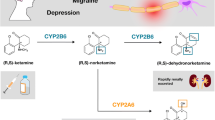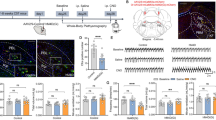Abstract
Clinical and animal studies have indicated that propofol has potential for abuse, but the specific neurobiological mechanism underlying propofol reward is not fully understood. The purpose of this study was to investigate the role of extracellular signal-regulated kinase (ERK) signal transduction pathways in the nucleus accumbens (NAc) in propofol self-administration. We tested the expression of p-ERK in the NAc following the maintenance of propofol self-administration in rats. We also assessed the effect of administration of SCH23390, an antagonist of the D1 dopamine receptor, on the expression of p-ERK in the NAc in propofol self-administering rats, and examined the effects of intra-NAc injection of U0126, an MEK inhibitor, on propofol reinforcement in rats. The results showed that the expression of p-ERK in the NAc increased significantly in rats maintained on propofol, and pre-treatment with SCH23390 inhibited the propofol self-administration and diminished the expression of p-ERK in the NAc. Moreover, intra-NAc injection of U0126 (4 µg/side) attenuated the propofol self-administration. The data suggest that ERK signal transduction pathways coupled with D1 dopamine receptors in the NAc may be involved in the maintenance of propofol self-administration and its rewarding effects.




Similar content being viewed by others
References
Roussin A, Montastruc JL, Lapeyre-Mestre M. Pharmacological and clinical evidences on the potential for abuse and dependence of propofol: a review of the literature. Fundam Clin Pharmacol 2007, 21: 459–466.
Bonnet U, Harkener J, Scherbaum N. A case report of propofol dependence in a physician. J Psychoactive Drugs 2008, 40: 215–217.
Fritz GA, Niemczyk WE. Propofol dependency in a lay person. Anesthesiology 2002, 96: 505–506.
Schneider U, Rada D, Rollnik JD, Passie T, Emrich HM. Propofol dependency after treatment of tension headache. Addict Biol 2001, 6: 263–265.
Pain L, Oberling P, Sandner G, Di Scala G. Effect of propofol on affective state as assessed by place conditioning paradigm in rats. Anesthesiology 1996, 85: 121–128.
Pain L, Oberling P, Sandner G, Di Scala G. Effect of midazolam on propofol-induced positive affective state assessed by place conditioning in rats. Anesthesiology 1997, 87: 935–943.
Lian Q, Wang B, Zhou W, Jin S, Xu L, Huang Q, et al. Self-administration of propofol is mediated by dopamine D1 receptors in nucleus accumbens in rats. Neuroscience 2013, 231: 373–383.
LeSage MG, Stafford D, Glowa JR. Abuse liability of the anesthetic propofol: self-administration of propofol in rats under fixed-ratio schedules of drug delivery. Psychopharmacology (Berl) 2000, 153: 148–154.
Chwang WB, O’Riordan KJ, Levenson JM, Sweatt JD. ERK/MAPK regulates hippocampal histone phosphorylation following contextual fear conditioning. Learn Mem 2006, 13: 322–328.
Einat H, Yuan P, Gould TD, Li J, Du J, Zhang L, et al. The role of the extracellular signal-regulated kinase signaling pathway in mood modulation. J Neurosci 2003, 23: 7311–7316.
Ortiz J, Harris HW, Guitart X, Terwilliger RZ, Haycock JW, Nestler EJ. Extracellular signal-regulated protein kinases (ERKs) and ERK kinase (MEK) in brain: regional distribution and regulation by chronic morphine. J Neurosci 1995, 15: 1285–1297.
Corbille AG, Valjent E, Marsicano G, Ledent C, Lutz B, Herve D, et al. Role of cannabinoid type 1 receptors in locomotor activity and striatal signaling in response to psychostimulants. J Neurosci 2007, 27: 6937–6947.
Valjent E, Pages C, Herve D, Girault JA, Caboche J. Addictive and non-addictive drugs induce distinct and specific patterns of ERK activation in mouse brain. Eur J Neurosci 2004, 19: 1826–1836.
Ozaki S, Narita M, Narita M, Ozaki M, Khotib J, Suzuki T. Role of extracellular signal-regulated kinase in the ventral tegmental area in the suppression of the morphine-induced rewarding effect in mice with sciatic nerve ligation. J Neurochem 2004, 88: 1389–1397.
Valjent E, Caboche J, Vanhoutte P. Mitogen-activated protein kinase/extracellular signal-regulated kinase induced gene regulation in brain: a molecular substrate for learning and memory? Mol Neurobiol 2001, 23: 83–99.
Valjent E, Corvol JC, Pages C, Besson MJ, Maldonado R, Caboche J. Involvement of the extracellular signal-regulated kinase cascade for cocaine-rewarding properties. J Neurosci 2000, 20: 8701–8709.
Valjent E, Aubier B, Corbille AG, Brami-Cherrier K, Caboche J, Topilko P, et al. Plasticity-associated gene Krox24/Zif268 is required for long-lasting behavioral effects of cocaine. J Neurosci 2006, 26: 4956–4960.
Zhou W, Liu H, Zhang F, Tang S, Zhu H, Lai M, et al. Role of acetylcholine transmission in nucleus accumbens and ventral tegmental area in heroin-seeking induced by conditioned cues. Neuroscience 2007, 144: 1209–1218.
Lai M, Zhu H, Sun A, Zhuang D, Fu D, Chen W, et al. The phosphodiesterase-4 inhibitor rolipram attenuates heroin-seeking behavior induced by cues or heroin priming in rats. Int J Neuropsychopharmacol 2014, 17: 1397–1407.
Sanna PP, Simpson C, Lutjens R, Koob G. ERK regulation in chronic ethanol exposure and withdrawal. Brain Res 2002, 948: 186–191.
Pan B, Zhong P, Sun D, Liu QS. Extracellular signal-regulated kinase signaling in the ventral tegmental area mediates cocaine-induced synaptic plasticity and rewarding effects. J Neurosci 2011, 31: 11244–11255.
Giorgi O, Corda MG, Sabariego M, Giugliano V, Piludu MA, Rosas M, et al. Differential effects of cocaine on extracellular signal-regulated kinase phosphorylation in nuclei of the extended amygdala and prefrontal cortex of psychogenetically selected Roman high- and low-avoidance rats. J Neurosci Res 2015, 93: 714–721.
Voyer D, Levesque D, Rompre PP. Repeated ventral midbrain neurotensin injections sensitize to amphetamine-induced locomotion and ERK activation: A role for NMDA receptors. Neuropharmacology 2016. doi:10.1016/j.neuropharm.2016.06.005.
Mao LM, Reusch JM, Fibuch EE, Liu Z, Wang JQ. Amphetamine increases phosphorylation of MAPK/ERK at synaptic sites in the rat striatum and medial prefrontal cortex. Brain Res 2013, 1494: 101–108.
Fishbein M, Gov S, Assaf F, Gafni M, Keren O, Sarne Y. Long-term behavioral and biochemical effects of an ultra-low dose of Delta9-tetrahydrocannabinol (THC): neuroprotection and ERK signaling. Exp Brain Res 2012, 221: 437–448.
Gomez AM, Sun WL, Midde NM, Harrod SB, Zhu J. Effects of environmental enrichment on ERK1/2 phosphorylation in the rat prefrontal cortex following nicotine-induced sensitization or nicotine self-administration. Eur J Neurosci 2015, 41: 109–119.
Haghparast A, Fatahi Z, Alamdary SZ, Reisi Z, Khodagholi F. Changes in the levels of p-ERK, p-CREB, and c-fos in rat mesocorticolimbic dopaminergic system after morphine-induced conditioned place preference: the role of acute and subchronic stress. Cell Mol Neurobiol 2014, 34: 277–288.
Pain L, Gobaille S, Schleef C, Aunis D, Oberling P. In vivo dopamine measurements in the nucleus accumbens after nonanesthetic and anesthetic doses of propofol in rats. Anesth Analg 2002, 95: 915–919.
Faccidomo S, Salling MC, Galunas C, Hodge CW. Operant ethanol self-administration increases extracellular-signal regulated protein kinase (ERK) phosphorylation in reward-related brain regions: selective regulation of positive reinforcement in the prefrontal cortex of C57BL/6 J mice. Psychopharmacology (Berl) 2015, 232: 3417–3430.
Valjent E, Pages C, Rogard M, Besson MJ, Maldonado R, Caboche J. Delta 9-tetrahydrocannabinol-induced MAPK/ERK and Elk-1 activation in vivo depends on dopaminergic transmission. Eur J Neurosci 2001, 14: 342–352.
Vossler MR, Yao H, York RD, Pan MG, Rim CS, Stork PJ. cAMP activates MAP kinase and Elk-1 through a B-Raf- and Rap1-dependent pathway. Cell 1997, 89: 73–82.
Yao H, York RD, Misra-Press A, Carr DW, Stork PJ. The cyclic adenosine monophosphate-dependent protein kinase (PKA) is required for the sustained activation of mitogen-activated kinases and gene expression by nerve growth factor. J Biol Chem 1998, 273: 8240–8247.
York RD, Yao H, Dillon T, Ellig CL, Eckert SP, McCleskey EW, et al. Rap1 mediates sustained MAP kinase activation induced by nerve growth factor. Nature 1998, 392: 622–626.
Lezcano N, Mrzljak L, Eubanks S, Levenson R, Goldman-Rakic P, Bergson C. Dual signaling regulated by calcyon, a D1 dopamine receptor interacting protein. Science 2000, 287: 1660–1664.
Gerdjikov TV, Ross GM, Beninger RJ. Place preference induced by nucleus accumbens amphetamine is impaired by antagonists of ERK or p38 MAP kinases in rats. Behav Neurosci 2004, 118: 740–750.
Iniguez SD, Warren BL, Neve RL, Russo SJ, Nestler EJ, Bolanos-Guzman CA. Viral-mediated expression of extracellular signal-regulated kinase-2 in the ventral tegmental area modulates behavioral responses to cocaine. Behav Brain Res 2010, 214: 460–464.
Acknowledgments
This work was supported in part by the National Natural Science Foundation of China (81271469 and 81471350), the Natural Science Foundation of Zhejiang Province, China (Z2101211 and Y20140692), and a Medical Health Project of Zhejiang Province, China (2014KYB161).
Author information
Authors and Affiliations
Corresponding authors
Rights and permissions
About this article
Cite this article
Wang, B., Yang, X., Sun, A. et al. Extracellular Signal-Regulated Kinase in Nucleus Accumbens Mediates Propofol Self-Administration in Rats. Neurosci. Bull. 32, 531–537 (2016). https://doi.org/10.1007/s12264-016-0066-1
Received:
Accepted:
Published:
Issue Date:
DOI: https://doi.org/10.1007/s12264-016-0066-1




